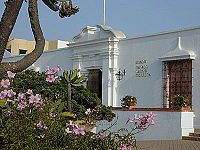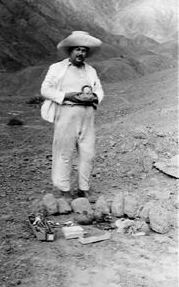
Rafael Larco Hoyle
Encyclopedia

Maryland
Maryland is a U.S. state located in the Mid Atlantic region of the United States, bordering Virginia, West Virginia, and the District of Columbia to its south and west; Pennsylvania to its north; and Delaware to its east...
, USA, at the age of twelve. He later entered Cornell University
Cornell University
Cornell University is an Ivy League university located in Ithaca, New York, United States. It is a private land-grant university, receiving annual funding from the State of New York for certain educational missions...
to study agricultural engineering
Agricultural engineering
Agricultural engineering is the engineering discipline that applies engineering science and technology to agricultural production and processing...
and by 1923 returned to Peru to work on the family's sugar cane plantation. After spending most of his youth abroad, Larco Hoyle arrived to Peru with the eyes of an outsider. With this foreigner's curiosity he explored the country and discovered an ancient cultural patrimony in the north coast. Larco Hoyle recognized the need to house these objects in a safe place. It was at that point, Larco Hoyle dreamt of a museum, one like he had seen in the United States.
In 1925, Larco Hoyle's father, Rafael Larco Herrera acquired a collection of vases and other archaeological pieces from Alfredo Hoyle, his brother-in-law. There were approximately 600 ceramic pieces in all. The arrival of these objects ignited a collector's enthusiasm in Larco Hoyle. Soon after, Larco Herrera left his son in charge of the collection and those pieces completed the first collection of what would become the Rafael Larco Herrera Museum.
During that same year, Larco Hoyle received some advice from his uncle, Victor Larco Herrera, a founder of the first museum in Lima. He urged Larco Hoyle to form a new museum in Lima, one that could guard all the archaeological relics that were continually being extracted by clandestine excavators.
Larco Hoyle agreed with his uncle. He yearned to erect a living monument in honor of his father whom he admired so much for his patriotism and love for Peru. He got to work creating a museum that would carry on his father's legacy. Larco Hoyle purchased two large collections: 8000 pieces from Roa and 6000 pieces from Carranza. He also purchased several small collections in Chicama Valley, Trujillo
Trujillo, Peru
Trujillo, in northwestern Peru, is the capital of the La Libertad Region, and the third largest city in Peru. The urban area has 811,979 inhabitants and is an economic hub in northern Peru...
, Virú
Virú Province
The Virú Province is one of twelve provinces of the La Libertad Region in Peru. The capital of this province is the city of Virú.-Political division:The province is divided into three districts, which are:* Chao* Guadalupito* Virú-External links:...
, and Chimbote
Chimbote
Chimbote is the largest city in the Ancash Region of Peru, and the capital of both Santa Province and Chimbote District.The city is located on the coast in Chimbote Bay, south of Trujillo and north of Lima on the North Pan-American highway. It is the start of a chain of important cities like...
. Within a year, the collection had grown significantly and display cases were installed in a small house on the Chiclín estate. On July 28, 1926, Independence Day, the Rafael Larco Herrera Museum
Larco Museum
The Larco Museum is a privately owned museum of pre-Columbian art, located in the Pueblo Libre District of Lima, Peru. The museum is housed in an 18th century vice-royal mansion built over a 7th century pre-Columbian pyramid. It showcases chronological galleries that provide a thorough overview of...
opened its doors to the public.
With the museum up and running and a collection of approximately 30,000 pieces, Larco Hoyle began classifying the collection. Peruvian archaeology was in its infancy and Larco Hoyle realized many typologies were yet to be recognized. He set out to correct that and approached archaeological research academically. During the 1930s, he discovered many distinct Peruvian cultures such as Viru, Salinar, Cupisnique
Cupisnique
Cupisnique was a pre-Columbian culture which flourished from ca. 1000 to 200 BC along what is presently Peru's Pacific Coast. The culture had a distinctive style of adobe clay architecture but shared artistic styles and religious symbols with the later Chavin culture which arose in the same area at...
, and Lambayeque. The focus of his research became the Mochica culture. In 1946, Larco Hoyle, director of the Larco Museum
Larco Museum
The Larco Museum is a privately owned museum of pre-Columbian art, located in the Pueblo Libre District of Lima, Peru. The museum is housed in an 18th century vice-royal mansion built over a 7th century pre-Columbian pyramid. It showcases chronological galleries that provide a thorough overview of...
, developed the first Peruvian chronology of ancient cultures, one that has remained current.
Archaeological Contributions

- Discovery of the archeological site of Cupisnique (1993).
- Discovery of the VirúVirúVirú is a town in Northern Peru, capital of the province Virú in the region La Libertad.-References:...
culture in the cemeteries of Pampa de los Cocos and Pampa de Moche (1933). - Discovery of Queneto and its ceramics (1934).
- Discovery of the pre- Cupisnique ceramics (1939).
- Discovery of the Cupisnique culture (1939).
- Discovery of the cemeteries containing ceramics called Cupisnique de Santa Ana and the culture of the same name (1939).
- Discovery of the cemeteries containing ceramics called Cupisnique de Santa Ana and the culture of the same name (1939).
- Discovery of tombs with hybrid ceramics Mochica - Virú (1940).
- Discovery of the Salinar culture (1941).
- Opening of the first tomb in the valley of Virú and find of the hybrid cemeteries called by him Virú - Cupisnique.
- Discovery of the hybrid vases Salinar - Cupisnique in the valley of Virú.
- Discovery of lithic tools used by the hunters in the Pre- Ceramics Age (pampas of Paiján and Cupisnique).
- Find of the vases of the Virú culture in the valleys of Chicama, Santa Catalina, Santa, Pacasmayo, Lambayeque and Piura.
- Discovery of the Virú vases, with positive ornamentation and called by him Virú of Chicama.
- Discovery of the Pacopampa ruins from the Evolutionary Age and of tools of the culture that existed there.
- Discovery of the pre - Mochica phase, called Complex Mochica or Initial Mochica.
- Find of tombs with orange vases and its relation with Virú vases, previous to Mochica.
- Find of the superimposed tombs and stratifications that allowed him to sort the five Mochica periods.
- Discovery of Barbacoa of Cupisnique, Salinar, Virú and Mochica superimposed tombs that resulted in the determination , for the first time, of the chronological order of the pre - Mochica cultures.
- Discovery of the fact that the Huari culture, called Tiahuanaco, spread all over the Peruvian territory and that its center was not Tiahuanaco but Huari in Ayacucho.
- Discovery and declaration of the existence of the Lambayeque culture which is sorted into two periods : Lambayeque I and II, and the Huari - Lambayeque culture, distinguishing the Chimú culture from the Lambayeque culture.
- Explanation of why it was not found the Middle Chimú, largely searched by the American archeologists proving that the Chimú cultureChimú CultureThe Chimú were the residents of Chimor, with its capital at the city of Chan Chan, a large adobe city in the Moche Valley of present-day Trujillo, Peru. The culture arose about 900 AD. The Inca ruler Tupac Inca Yupanqui led a campaign which conquered the Chimú around 1470 AD,.This was just fifty...
is the result of the fusion of Mochica, Lambayeque and Huari cultural elements. - Classification, for the first time, of what nowadays is called Chimú - Inca ceramics, distinguishing it from the Chimú ceramics.
- Discovery of ceramics of Incaic shapes with Spanish glaze.
- Discovery of the fact that the culture called Recuay or Callejón de Huaylas had its center in the valley of Santa and not in the mountains, as it was thought.
- Finds, for the first time, of Santa ceramics in the valleys of Chao and Virú.
- Discovery of the fact that the center of the italic ceramics - that some considered Chimú - was the Lambayeque department. He named and described it.
- Determination of the sequence of the adobes in the constructions, beginning with the Cupisnique conic sections, the Salinar spherical skullcaps and Mochica and Chimú types of rectangular sections.
- Discovery of the fact that the Chimú settlers used and worked with bricks.
- Statement of the deity evolution, from the feline to the God - Man, with large canines and wrinkled face that is represented in the Peak Age.
- Discovery of the Mochica writing after its spread all over the Peruvian territory.
- Statement that the Maya and Mochica writings have the same origins.
- Discovery of the Pre - Ceramics Age in Paracas.
- Division of the study on the evolution of the Peruvian cultures into seven ages : Pre -Ceramics, Initial Age of the Ceramics, Evolutionary, Peak, Fusional, Imperial and Conquest.
- Classification of the Huari ceramics into Huari A, Huari B and Huari C which represents the total decline of this culture.
- Demonstration, for the first time, of the charts of the different coast valleys and of the main mountain centers classifying them by ages and periods and including within them the cultures settled in those places.
- Discovery of the fact that the Mochicas used lead and iron.
- Discovery of the fact that the Vicus silvered the copper and gilded it on its outside part.
- Discovery of the fact that the Chimú silvered the copper.
- Statement that the origins of Mochica I are placed in Vicus.
- Sorting, for the first time, of the Mochica and other cultures funerary ceramics by subject and series.
- Discovery of the fact that the circumcision was practiced by the ancient Mochicas.
- Verification of the existence of the syphilis in the ancient Peru.
- Statement, for the first time, that there was not a Chavín empire but a decorative style used by other cultures of the Evolutionary or Formative Age.
- Find of white over red Salinar vases in Piura, Chiclayo, Pacasmayo, Valley of Chicama, Santa Catalina, Virú, Chao, Santa and Nazca.
- Statement of the complete chronology pertaining to the cultures in the north of Peru which is included in his book CRONOLOGÍA ARQUEOLÓGICA DEL NORTE (ARCHEOLOGICAL CHRONOLOGY OF THE NORTH), published in 1948. The cultural sequence has been verified by foreign groups of archeologists.
- Statement, for the first time, that the incised ceramics called Chavín cannot be considered a horizon because in that way the vases with negative ornamentation and the cream over red vases would have to be considered horizons as well

